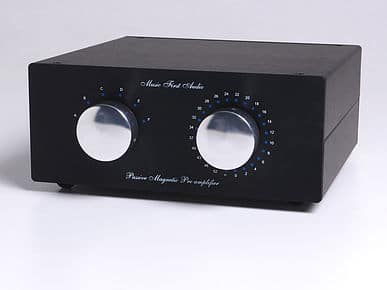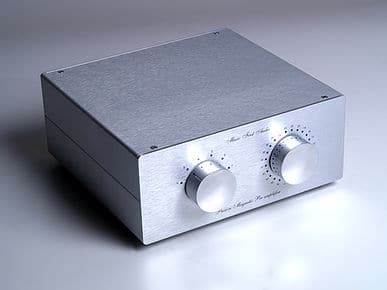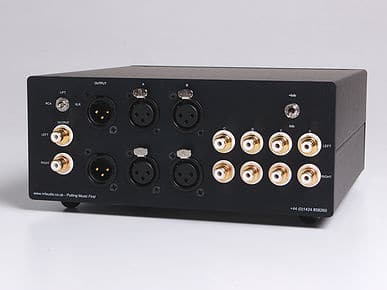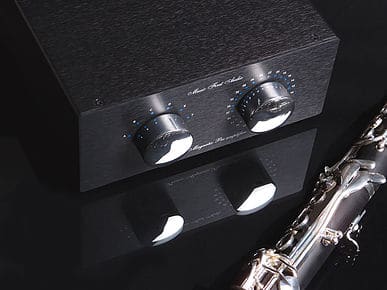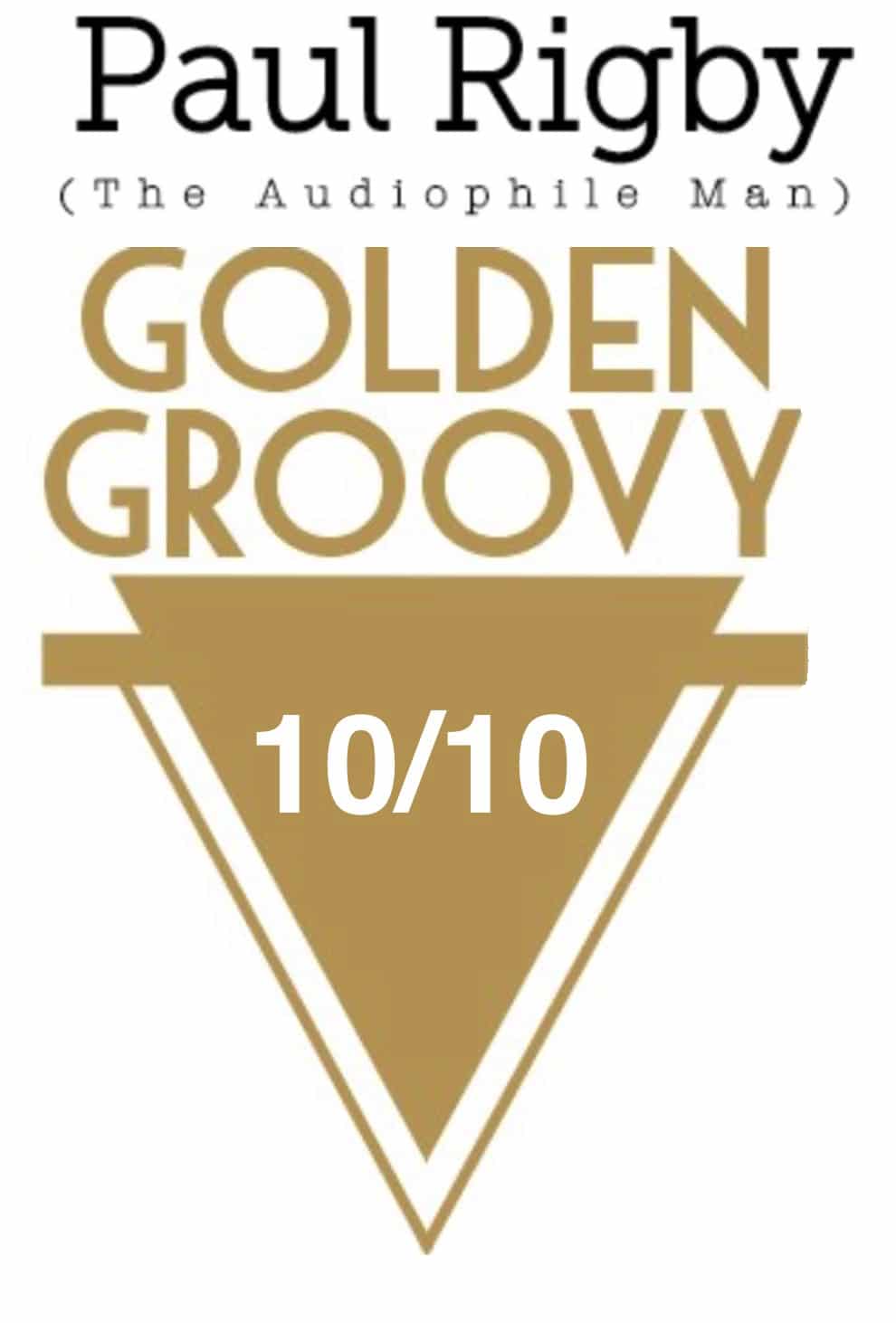The Article
Music First Audio’s Classic passive pre-amp: Look! No Plug!
3rd February 2016
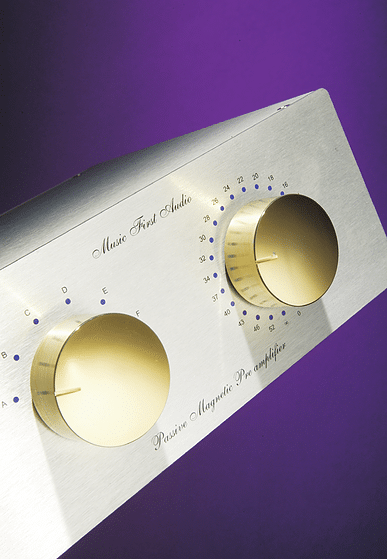
Music First Audio is a specialist in transformer production, Paul Rigby reviews the Classic passive pre-amp which is full of ‘em
Imagine you’ve got half a dozen eggs in a box. Now, open the box. You can see six, recently laid eggs, right? If you are going to make a boiled egg, which egg would you take first? Yes, I know it’s an odd question but bear with me on this. Which one? Let’s say you took the upper left, for the sake of argument. OK, next day, you’re back, hungry for breakfast again and it’s another boiled egg for you. Which one do you take now? One in the middle? Top right, perhaps? Music First Audio owner, Jonathan Billington, would choose the bottom right. He would then take the top right, the next day, followed by the bottom left the day after that. Do you see? It keeps things balanced. Neat. Tidy. This is how Billington’s mind works. This is how he views life itself. This mind-set is most probably genetic. Maybe that’s why his folks have been making top quality transformers since 1963 and why Jonathan Billington has been making superb examples since 1978 because, to make transformers that reach into the level of genius, this is the sort of mind you need.
Such transformers occupy the chassis of his Classic passive pre-amp. This model was released in 2003 and so, you might say, “Paul, your a tad late with this particular review, ain’t you ol’son?” Reason is that I was about to review Music First’s latest version of its much more expensive Baby Reference when I heard that the Classic is destined for retirement. Not because it’s past its best – far from it. But, as Billington himself said, “It’s very difficult to earn a living selling things at £2,040. It sounds incredible doesn’t it? Take away the VAT and you’re down to £1,700 and that’s not very profitable for a small business which also has to include costs for travelling to shows and renting space, etc.”
So, this pre-amp will be gone next year. This review is more of an awareness piece, I suppose. It’s a sort of kick-in-the-pants-type review for anyone looking to buy a pre-amp or thinking of upgrading. It’s also for anyone looking for a (relative) bargain.
Being a passive pre-amp, the Classic has no power supply, no power switch, no power cable and no plug. It just sits there. Waiting for a signal from a source which it then passes down the line to your power amp. I wondered if the whole idea of a passive pre was to enable you to effectively get rid of the pre and virtually, as it where, plug your source into the power amp?
“Not really, no,” said Billington, shooting down that particular theory. “Source equipment, CD player or tuner and so on, doesn’t normally come with a volume control, many phono stages don’t or even a Sky digibox. So you either have to use an integrated pre-amp or a pre-amp followed by a power amp. The pre-amp is there to allow you to select your source and adjust the volume.”
So why passive at all? What’s the issue with a powered pre-amp? Why bother with a passive design? According to Billington, because, “…you end up listening to the pre-amp rather than the source. The active pre puts its own signature on the sound. Let’s say your CD player is playing. It pumps out, what, 2V? You plug in your active pre-amp which sucks in 240V from the wall, turns it into 24V or so, that’s then rectified, turning into around 18V DC. That’s then stored, possibly into capacitors. You then plug your source into the pre, then use the signal that’s coming out of the source which modulates the stored voltage, via a series of transistors or valves and turns that DC back into either higher voltage version of the CD output or a lower version. So, you’re taking the output of your CD player and you’re using it to modulate the regulated power supply of the pre-amp. This is a ridiculous way of turning volume up or down because you end up listening to the transistor or valve components and the power supply components.”
This, says Billington, is why active pre-amps are flawed. They impose their own sound upon your listening chain. By doing it passively, you don’t plug it into the wall and you don’t listen to the pre-amp. Which is fine but, surely, even a passive pre would impose something of itself onto the sound?
“With clever transformer design, you do your best to remove any transformer signature from the process,” said Billington. “Of course, with experience and time and listening to customers, I realised that I could still improve upon it. The Classic has seen further improvements with my more expensive products. Yes, there is internal wire, internal soldering and the like so care has to be given to construction and component quality. In this way, I think that I’ve avoided putting any component signature in the chain.”
You can create a pre using resistors but it shouldn’t be done this way. That’s not Billington the engineer talking, that’s me and my ears. Transformers are the way to go. If you design a resistor-based pre then you apply your full source output to the top of the chain and then, going down the chain, you pick off smaller voltages – hence the music gets quieter. There are flaws to this. As you go down in volume, you add series resistance and source impedance. Hence, it becomes more difficult to drive capacitive cable and you also lose high frequencies. The result, in sonic terms, is a bland and crushingly boring sound. There was a time, not that long ago, though, when the resistor method was the only game in town.
Some people made excuses for this system and said that it had a ‘nice warm valve sound’ but, “You don’t want to listen to ‘nice warm valve sound’, you want to listen to a grand piano sounding like a grand piano! Why would you want to ‘warm’ it up with a valve? Andre Previn didn’t plug his piano into a Marshall amp to make it warmer! The passive way is the right way. The resistive method was flawed. The maths is there.”
The Classic stems from a broadcast-level hardware project from 1998, a line bridging transformer for broadcast use to go across a 600 Ohm line to drive a high impedance output on a power amp of some description. The idea escaped into the enthusiasts market, though, and evolved after a number of members of the HiFi Club of London offered instant demand, “I built more than a 1,000 for the DIY market. A lot of late nights,” said Billington “I then thought that I should put them in my own boxes and sell them under the family business name of Stevens & Billington but I didn’t think that said much about the product or the philosophy behind it. That’s when I decided to call the company Music First Audio. That was 2003.”
WALK-AROUND
So, let’s take a closer look at the Classic itself. The large volume knob on the front is an expensive ELMA, a military grade rotary switch, with gold plated contacts. The ELMA is a 24-position switch, “You apply all your volts to your transformer,” said Billington. “That transformer has 24 wires coming out per channel (48 in all). It’s a switch contact. It gets quieter in 24 discrete steps. The switch on the front decides which one of those connections that you want to listen to. Each part is an individual contact.”
The input selector is from ELMA too. It’s a two pole switch, so you switch between your CD ‘hot’ in and your CD ‘cold’ in and so on (i.e. the live and ground connections).
“Many powered solutions would use a similar system but a cheaper switch on most occasions. The reason I use the most expensive switches for the Classic is because, sadly, this company is not run by an accountant but a lunatic engineer. It appears that earning a living seems to be the last of my worries.”
Around the back are six inputs. Two are balanced and four unbalanced, basic phono RCAs. The output side, and this is the big advantage of a transformer pre-amp, has a pair of unbalanced and balanced outputs.
There’s two other switches, “We added a 6db of gain switch because some people might be using a 1960s phono stage or tuner. As time has gone by, the hi-fi industry, for some reason, has decided to use higher and higher output voltages. In the broadcast world, the one I come from, a standard line level would be 0.775V, known as 0db. In the 60s, in the hifi industry, that was the figure too, as standard…maybe it was even less. Because marketing men get involved in hi-fi, some bright spark said, ‘Well, if our phono stage gives out twice 0.775V, then we can proclaim a bigger output which means that it’s ‘better’.’ Some modern CD players are giving 7V out which is 10 times more than you need.”
The 6db switch adds gain to the 1960s units. Useful if it’s not quite loud enough. Also, at the back is a three-position grounding switch for hum loop issues. With a well designed and built source and power amp then the ‘grounding’ position is best. If anything is peculiar (say, a 1960s Leak power amp), the other positions might be useful.
Inside are two TX102 transformers with dual primary windings and a 24-position secondary winding, “They are my designs,” said Billington. “It features an intricate design which includes extremely neat, accurate and tidy winding. The quality of the materials and core materials are carefully chosen. At the time, it was the largest attenuation transformer that you could buy, core size-wise. The core is an 80% nickel, 19% iron and 1% copper core material. The transformer is the heart and soul of the pre.”
Inside are also a network of grounding resistors which are taken to the case work. Each channel has its own resistor. Used to drain static build up on the ground side of the inputs.
Transformer manufacturing is more of an art than a science, it’s known in electronics to be so. If you read the physics books on how transformers work and then use those books to make one, your final transformer won’t work very well because you also have to control leakage/capacitances, leakage/inductances and so on, “You have to keep all these things under control,” confirmed Billington. “When you wind a transformer, you don’t just put copper wire onto a bobbin, you interleave it with paper, different types of tape between the windings, you carefully work out how you bring your input/output wires in and out of the transformer, you build it up in layers. You can’t put that into a physics scenario really. Transformer design is a compromise. In a perfect world, you would freeze your transformer to -273 degrees and it would be the size of a skyscraper. That way, you would have no copper losses whatsoever, you wouldn’t have to introduce a metal core because you could get all of the electrical properties you need from the skyscraper turns of copper wire.”
For now, we’ll have to rely on a smaller transformer that sits in this diminutive chassis. What does it all sound like then?
SOUND QUALITY
Spinning the vinyl version of Peter Hammill’s The Love Songs and Just Good Friends, my first reaction to the Classic, was “Wow!”, quickly followed by an additional, “Bloody hell!”
But allow me to put some meat on that and provide context. From the first few moments I was hit by a heap of new information. Firstly, the quietude. This box gives you zero noise. Nothing. Nada. Having struggled with noise (distortive noise not buzzes, etc, of course) in all aspects of my hi-fi chain (not helped by the fact that I use valve components throughout) I was staggered by the quiet offered by the Music First. Hence, Hammill’s vocal delivery was smooth, breathy, emotive, cultured, nuanced and subtle all at once. What I didn’t have was noise attaching itself to the frequencies, coating and hiding essential information.
The lack of noise also did amazing things to the drums. Up until this point, I thought I knew what a drum sounded like from a recorded source. Sounds silly even reading that, doesn’t it? Apparently not, though. The Music First taught me a lesson or two. Percussion sounded tonally precise, accurate, big, massy, hefty and strong. How each instrument connected together sounded more fluid and natural.
Also, this is a compressed recording and can, in places such as as vocal crescendos, reach rather bright levels in the upper mids. The Music First managed to dampen down the nasty effects. What it was doing was addressing the compressed dynamics and, firstly, taking out the noise that accentuates compression during playback but also providing enough headroom at the top of the sound frequency spectrum to allow the music room to manoeuvre. Yes, the compression was still there but it was nowhere near as dangerous to the ears.
Quite apart from pre-amps at a similar price point, the Music First performed up to and sometimes beyond the standards of my reference Aesthetic Calypso (which is rated at more than twice the price and is, in itself, considered to be a considerable bargain).
Moving to jazz and Ella Fitzgerald’s When the Sun Comes Out from The Harold Arlen Songbook. This is an excellent pressing via the German audiophile label, Speakers Corner, so the disc is performing at the top of its game to begin with.
The Music First Classic keeps it there. Fitzgerald’s smooth vocal is more than that, though. Lesser quality pre-amps will rely and depend on that smoothness to see them through any inherent rocky patches within their own design but the Music First adds more body and emotion to the Fitzgerald delivery, giving the voice a force and effort when required. You can hear her strain her vocal chords at times while the pumped ‘p’ at the beginning of the sung word “peaches”, right into that vintage ribbon microphone, is easily discernible as it pops right up front.
Her orchestral jazz backing is also lively and full of energy. The brass section was dynamic and packed with texture. You can almost see the trumpet player’s lips rotating as he produces power during crescendos. Saxophones slipped and slided, tracking the breath that the player gave to this emotive instrument while the lazy strumming of the guitar, during the early stages of the track, reduced the amount of bass blur that can emanate from lesser pre-amps, masking the metallic strings. The Music First offered tonally accurate performance from the instrument while the percussion was clean, precise, full of impact but also characterful.
Finally, the garage rock from The Rockets (who would splinter off and become Neil Young’s backing band, Crazy Horse) offered the roots-based pop/rock of Hole In My Pocket which presented excellent instrumental separation. This sort of all out, raw, edgy presentation can result in a blobby amalgam of frequencies. It takes a refined pre to separate those frequencies but the Music First did just that, giving the music more body and finesse.
CONCLUSION
The sound output was, for the money, incredible. Actually, that doesn’t really describe it. The reduction in noise added a significant added amount of detail which resulted in clarity to die for. The open and natural sound that the Music First produces gave the sound output a sense of realism that is rare to hear at any price, never mind a few pounds over £2,000. This is more than a stunning pre-amp, it is a complete game changer in terms of pre-amps. You really have to ask yourself, “What is the point of a powered pre-amp? What do I gain from such a design?” After hearing the Classic, I really struggle to find a positive answer to that one. As such, I have to give the Classic the coveted and very rare Golden Groovy. Only the third time that I have awarded this one in around 70 or so reviews but the Classic deserves it. More to the point, this pre will not be around for too much longer so, if you are in the market for a pre, get it while you can!
MUSIC FIRST AUDIO CLASSIC PASSIVE PRE-AMP
Website: www.mfaudio.co.uk
Tel: 01424 858260
Price: £2,040
Good: value, clarity, low noise, transparency, insight, etc, etc
Bad: nothing at the price
Rating: 10
REFERENCE SYSTEM
Avid Acutus turntable
SME IV arm
Koetsu Black cartridge
Icon Audio PS3 phono amp
Aesthetic Calypso pre-amp
Icon Audio MB845 Mk.II
Quad ESL57 speakers with One Thing upgrade
Vertex AQ & Tellurium Q cables

